People with a severe-to-profound hearing loss (SPHL) need hearing aids that are chosen more carefully than those for people with milder degree losses. In addition to the obviously higher gain requirements, people with SPHL have a number of unique hearing needs that should be addressed during the selection, fitting, and counseling process. Reported here are the features of a new high-end hearing aid, the Widex SUPER440, designed for people with SPHL, as well as the results from a field study that was designed to test the real-world effectiveness of the new device.




This article was submitted to HR by Tatiana Solberg, MA, and Helle S. Joergensen, MA, members of the Audiological Research Department at Widex A/S, Lynge, Denmark; Lars Baekgaard, MSc, a team leader in the Research and Development Department of Widex A/S; and Noor Bremmers, an audiologist who serves as audiological trainer with Veenhuis Medical Audio BV, Gouda, the Netherlands, and who has experience as a clinical audiologist.
A wireless digital high-end receiver-in-the-ear (RITE) super-power hearing aid, the SUPER440, has been introduced by Widex to provide maximum audibility for people with severe-to-profound hearing loss. Based on the company’s C-ISP platform, it offers a number of features that address the essential requirements of hearing aid users with severe-to-profound hearing loss that are detailed in this paper. Additionally, results from a field trial on this device are reported here.
With a maximum output of 138 dBSPL and a maximum peak gain of 78 dB (measured in a 2cc coupler), SUPER440 is suitable for clients with PTAs greater than 100 dBHL. The high output level is achieved through a combination of a high amount of gain, a powerful receiver, and a highly effective amplifier. Additionally, a sophisticated InterEar feedback canceling system, capable of distinguishing true feedback from feedback-like environmental sounds (eg, alarms), and tightly fitting custom earmolds contribute to a higher maximum gain by reducing the risk of feedback.
The custom earmolds used in the new device are constructed with great precision to fit optimally in the individual ear. CAMISHA laser technology is used to turn an impression of the client’s ear canal into a tightly fitting custom earmold, which can be either soft or hard, depending on the client’s requirements.
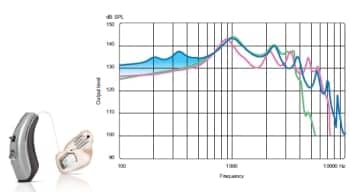
Figure 1. Left: A SUPER440 hearing aid with an Output Extender earmold containing the receiver and the folded sound bore. Right: SUPER440 with the SP-receiver and Output Extender provides 3-5 dB more low-frequency output than some of the most recent competitive super-power products.
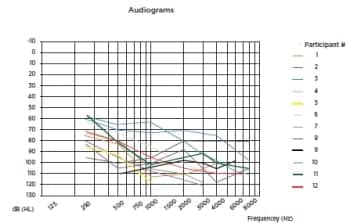
Figure 2. Audiometric configuration (averaged across the left and right ear) of the 12 participants.
A special earmold is available for clients who need as much power as possible. The earmold contains what has been dubbed an “Output Extender”—a 60 mm folded sound bore, which is inserted into a hard custom earmold by means of CAMISHA technology. Compared to a regular straight sound bore, the Output Extender increases hearing aid output by as much as 7 dB in the 1 kHz region.
As shown in Figure 1, the maximum output of the device is 3-5 dB greater than the output provided by two of the most recent competing super-power products across the low-frequency range. For clients with “left corner” audiograms—for whom every dB counts and where the limited amount of residual hearing is restricted to the lower frequencies—this extra output can make a significant difference in achieved audibility.
High Output Levels Require Effective Protection
While high gain levels are necessary to compensate for a severe degree of hearing loss, the application of too much gain may result in distortion and cause the wearer considerable discomfort.
As a means of avoiding over-amplification, SUPER440 offers an Automatic Output Control (AOC) function that reduces gain when the output signal reaches the distortion limit of the hearing aid, then increases it again once the signal is below the limit. As sensitivity to high output levels and distortion can differ considerably from client to client, the AOC function can be activated and deactivated as required in the fitting software.
Additionally, protection from over-amplification of sudden loud sounds, such as a slamming door, is provided by an advanced, fast-acting system capable of taking the client’s hearing loss into account when determining the appropriate gain reduction. The system is also designed to distinguish between speech sounds and environmental sounds, so that the audibility and intelligibility of speech are not affected by this system.
High Sound Quality for Effective Audibility
The extensive damage to the inner hair cells that characterizes severe-to-profound hearing loss means that clients in this group are much more susceptible to background noise and signal distortion than normal-hearing people and people with milder hearing losses. Thus, amplifying the signal sufficiently above the hearing threshold is a first important step toward restoring audibility, but it is not sufficient in itself to ensure that severely-to-profoundly impaired listeners are able to extract relevant information from the signal. In order to obtain effective audibility, people with severe-to-profound hearing loss also need good signal-to-noise ratios (SNRs), a hearing aid output that is as distortion-free as possible, and a signal that contains as many as possible of the characteristics (temporal as well as spectral) of the original signal.1
Experimental evidence2 has shown that speech recognition in people with a severe degree of hearing loss is best supported by wide dynamic range compression (WDRC) with slow-acting gain regulation and a low compression ratio. SUPER440 therefore offers an adaptive WDRC system that employs slow-acting gain regulation and low compression ratios in stable sound environments, while faster regulation and higher compression ratios are permitted in abruptly changing environments.
Research has also shown that directional microphones can improve audibility in noise for people with severe-to-profound hearing loss.3 The new device features an automatic adaptive directional microphone system.
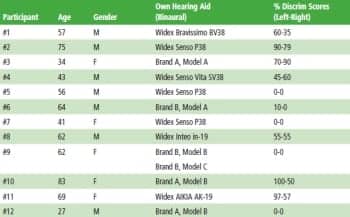
Table 1. Information regarding the participants’ age, gender, own hearing aids, and discrimination ability.
Additionally, it offers two noise reduction schemes: Noise Reduction and Speech Enhancer. The Noise Reduction feature is designed with the emphasis on maximizing comfort in noisy surroundings. The Speech Enhancer, on the other hand, is designed to provide optimum speech perception in noise by increasing gain in frequency regions where speech is present, while suppressing noise in other frequency regions.
Internal trials have shown that the Noise Reduction feature is preferred by the majority of hearing aid users with severe-to-profound hearing loss. The Noise Reduction feature is therefore active by default in SUPER440. The Speech Enhancer feature may be selected in the fitting software, for example, to allow a client whose hearing loss is toward the moderate end of the severe category and reasonably good discrimination to try it out.
One of the most effective means of improving the SNR is to use wireless assistive listening systems that pick up sound close to the source and transmit it directly to the hearing aids.4 The new hearing device offers connectivity with several assistive listening systems, including telecoil, FM, and the Widex DEX, which include a TV-DEX for TV viewing, an M-DEX for mobile calls, and a PHONE-DEX for landline calls.
The Audibility Extender feature that is available in SUPER440 is capable of rendering high-frequency sound audible by shifting it from the unaidable high-frequency region to a lower frequency region where some residual hearing remains. Studies have found positive outcomes from this feature in the form of improved speech perception in people with precipitously sloping as well as “left corner” audiograms.5,6 This suggests that the Audibility Extender feature may provide a good alternative to traditional amplification for clients with severe-to-profound hearing loss in the high-frequency region.
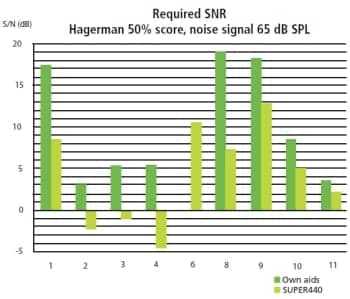
Figure 3. The signal-to-noise ratio at which 50% correct identification scores were obtained in the Hagerman test with the participants’ own hearing aids and SUPER440 with the SP-receiver (n=9).
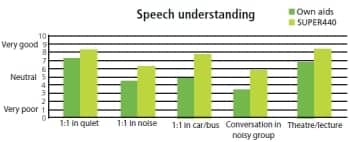
Figure 4. Average ratings for speech comprehension with own hearing aids vs SUPER440 during 1-to-1 conversations in quiet, noise, while traveling in a car or on a bus, in conversations in a noisy group, and at a theater or lecture (n=9).
Laboratory Results
The remainder of this paper reports the results of a study designed to investigate whether the features described above do indeed improve audibility for super-power users in real-life situations.
Possible user benefits of SUPER440 have been investigated in the laboratory, as well as real-world trials involving 12 hearing aid users with severe-to-profound hearing loss. A total of 7 males and 5 females ages 27 to 83 (mean age 56) participated in the trials. All participants were experienced hearing aid users of digital super-power BTEs. Information on the participants’ hearing thresholds, discrimination scores (obtained prior to the trial at a hospital clinic), age, and own hearing aids is presented in Figure 2 and Table 1.
The participants were fitted with SUPER440 hearing aids with SP receivers and custom earmolds selected according to their individual needs and preferences. A total of 7 were fitted with soft custom earmolds, 3 were fitted with hard Output Extender earmolds, and 1 was fitted with a hard custom earmold with a regular, straight sound bore. The participants were tested with their own hearing aids and the test hearing aids in a laboratory trial at the initial fitting. They subsequently wore the test hearing aids at home for a period of 4 to 5 weeks, then on their return answered a number of questions regarding their ability to hear in various real-life situations.
Speech understanding in noise. Laboratory results on speech understanding in noise were obtained from 9 of the 12 participants. The remaining 3 (participants #5, #7, and #12) had speech perception ability that was too poor to allow them to complete the test, either with their own hearing aids or with the test hearing aids (Table 1).
The participants’ ability to hear speech in noise was tested by means of a Hagerman test.7 This test is based on sentences consisting of five words each, pre-recorded by a female speaker. Speech recognition in noise is measured by determining the SNR at which 50% correct identification of the test words is reached. The sentences are presented in randomized order from a loudspeaker located directly in front of the listener. The speech stimuli are mixed with multi-talker babble noise, presented at 65 dB from five loudspeakers located to the sides and the rear of the listener. Listeners are instructed to repeat as many of the words as possible in each sentence. The experimenter records the number of correct words on a computer, and the SNR is automatically adjusted on the basis of this score until the 50% correct identification level was reached.
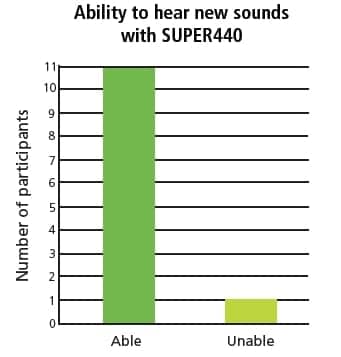
Figure 5. Distribution of participants who were able or unable to hear new sounds with the test hearing aids, compared to their own hearing aids (n=12).
The Hagerman test was performed with both the participants’ own hearing aids and the test hearing aids for 8 participants. The default settings and features (eg, adaptive directional microphone system, noise reduction algorithm, feedback cancellation algorithm, etc) of the test hearing aids were enabled during the trial. The results are shown in Figure 3. As shown, although there was great variation in performance, the 8 participants had notably better speech recognition in noise with the test hearing aids than with their own hearing aids. Differences in required SNR of as much as 9-12 dB were observed for some of the participants with the test hearing aids, compared to their own hearing aids. One (#6) was able to perform the test with the test hearing aids, but not with his own devices. On average, the required SNR was 6.7 dB less with the test hearing aids than with the participants’ own hearing aids.
Field Trial Results
There is no guarantee that laboratory results carry over into everyday situations. Thus, the large improvements in speech perception in noise were investigated in separate trials involving various real-life situations.
The subjects trialed the test hearing aids at home for a period of 4 to 5 weeks with all the default features (adaptive directional microphones, noise reduction feature, IE feedback canceling, etc) enabled. After the trial, they rated their self-perceived ability to hear speech and environmental sounds in various everyday situations with their own devices and with the test hearing aids.
Speech understanding. The 9 participants who were able to perform the objective speech test described above were asked a number of questions regarding their self-perceived ability to hear speech in various situations. The remaining 3 participants were excluded from this part of the trial as they would be relying exclusively on lip-reading.
The participants rated their own speech perception ability in 1-to-1 conversations in quiet and in noise, while traveling in a car or on a bus, in a theater/lecture hall, and in a noisy group with their own hearing aids compared to the test hearing aid. Ratings were obtained using a 0-10 scale, with 1 indicating a very poor ability and 9 indicating a very high ability. Average ratings for each condition are shown in Figure 4.
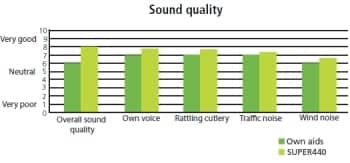
Figure 6. Average ratings of the subjectively perceived sound quality of SUPER440 and the participants’ own devices (n=12).
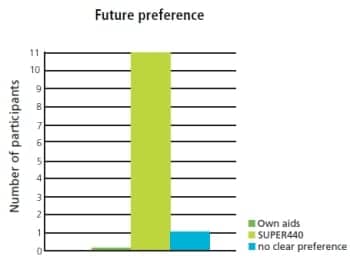
Figure 7. Distribution of participant responses when asked which hearing aids they would prefer to wear in the future (n=12).
The participants rated the test hearing aids as superior to their own hearing aids in all five environments. The strongest preference for the test hearing aids was seen in environments with background noise. This suggests that the features in the new device that have been designed specifically to optimize hearing in noise do, in fact, perform well for this group.
Environmental sounds. The participants were also asked if they had been able to hear sounds with the test hearing aids that they were unable to hear with their own devices (Figure 5). The majority (11 of 12) reported being able to hear environmental sounds and/or speech sounds with the test hearing aids that had previously been inaudible to them. These included the ability to hear their car radio and conversations in a car, individual talkers in larger group settings (eg, wedding, golf clubhouse event, etc), fountains and rustling birch trees, and snapping fingers.
The participants were also asked to evaluate the test hearing aids in terms of sound quality in a number of everyday situations. They were asked to rate the overall sound quality, the sound quality of their own voices, the sound of rattling cutlery, annoyance from wind noise and traffic noise, and the occurrence of feedback with SUPER440 compared to their own devices. There was a consistent preference for the sound quality of the new device in the situations that were evaluated. Average ratings are shown in Figure 6.
Device preference. At the end of the trial period, the participants were asked whether they would prefer to continue using the test hearing aids or return to their own devices. The majority (11 of 12) responded that they would continue with SUPER440 if they could (Figure 7). One participant had no clear priority for one over the other. Her job at a kindergarten meant that she preferred to wear her own hearing aids at work, because the children sounded too noisy with the test hearing aids, while preferring the test hearing aids at home, where her priority was to hear as much as possible. None of the participants replied that they would prefer to go back to wearing their own hearing aids.
Conclusion
Effective audibility is now within reach of people with severe-to-profound hearing loss. Until now, substantial improvements in speech recognition in noise would have been beyond what could reasonably be expected for this target group. However, marked improvements in speech perception in noise were observed with SUPER440 in a laboratory trial. Results from subsequent real-life trials also indicated that the features included in this device to optimize effective audibility had, in fact, succeeded in increasing the range of both environmental and speech sounds for the great majority of participants.
Plenty of challenges still remain for the super-power target group despite the recent technological advances in digital hearing aid technology. However, there are indications that the features developed to make the most of the residual hearing of this target group are, in fact, capable of generating improvements substantial enough to make a difference to their everyday lives.





